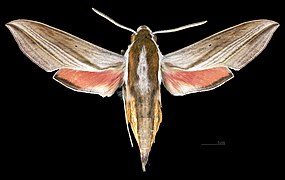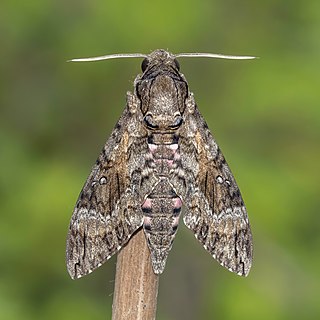
Agrius cingulata, the pink-spotted hawkmoth or sweetpotato hornworm, is a moth in the family Sphingidae. The species was first described by Johan Christian Fabricius in 1775.

Psilogramma menephron, the privet hawk moth or large brown hawkmoth, is a member of the family Sphingidae. It was described by Pieter Cramer in 1780. It is usually found in Sri Lanka, India, Nepal, central and southern China, Thailand, Vietnam, Indonesia and the Philippines. Psilogramma casuarinae from eastern Australia was long treated as a synonym but is now thought to be a distinct species. The introduced population on Hawaii was first thought to be P. menephron, but is Psilogramma increta.

Theretra oldenlandiae, the impatiens hawkmoth, taro hornworm or white-banded hunter hawkmoth, is a member of the family Sphingidae.

Nephele hespera, the crepuscular hawkmoth, is a sphingid moth described by Johan Christian Fabricius in 1775.
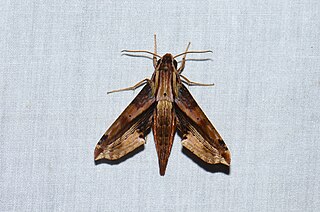
Eupanacra mydon, the common rippled hawkmoth, is a moth of the family Sphingidae.

Theretra latreillii, the pale brown hawk moth, is a moth of the family Sphingidae described by William Sharp Macleay in 1826. It is found in most of Asia, including Borneo, China, Hong Kong, the Philippines, Taiwan and also throughout the tropical and temperate regions of Australia.

Theretra nessus, the yam hawk moth, is a moth of the family Sphingidae. It was described by Dru Drury in 1773.

Theretra silhetensis, the brown-banded hunter hawkmoth, is a moth of the family Sphingidae described by Francis Walker in 1856. It lives in Indo-Australia, India, Sri Lanka, Papua New Guinea, East Australia, Solomon Islands, Fiji Islands, Vanuatu Islands.

Hippotion echeclus, the black-based striated hawkmoth, is a moth of the family Sphingidae. *
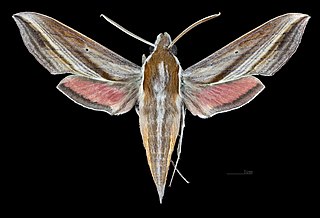
Hippotion rafflesii, the Raffles' striated hawkmoth, is a moth of the family Sphingidae. It is known from Sri Lanka, southern and eastern India, Nepal, Myanmar, Thailand, southern China, Malaysia (Peninsular), Indonesia and the Philippines.

Hippotion rosetta, or Swinhoe's striated hawkmoth, is a species of sphingid moth in the family Sphingidae. The species was first described by Charles Swinhoe in 1892.

Hippotion velox, the dark striated hawkmoth, is a species of sphingid moth or the family Sphingidae. The species was described by Johan Christian Fabricius in 1793.
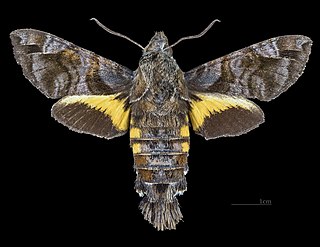
Macroglossum insipida, the hermit hummingbird hawkmoth, is a moth of the family Sphingidae. It was described by Arthur Gardiner Butler in 1875.

Daphnusa ocellaris, the durian hawkmoth, is a species of moth of the family Sphingidae.

The Australian striped hawk moth is a moth of the family Sphingidae first described by the Scottish-born Australian medical practitioner, naturalist, author, philosopher and utopianist; Thomas Pennington Lucas in 1892. H. livornicoides was once a common food source for the Arrente community in Central Australia, however is not consumed anymore due to their sacredness and increasing scarcity. The local name for the caterpillar is 'Ayepe-arenye', often anglicised as 'Yeperenye' or 'Yipirinya'.
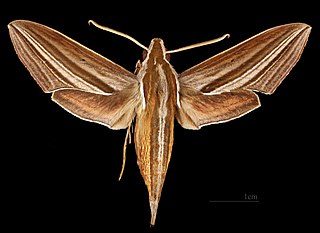
Theretra lycetus, the white-edged hunter hawkmoth, is a moth of the family Sphingidae. It was described by Pieter Cramer in 1775.
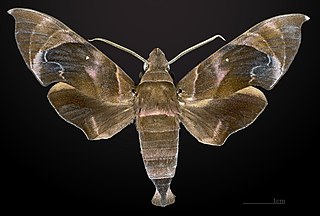
Eurypteryx bhaga, the hook-winged hawkmoth, is a moth of the family Sphingidae first described by Frederic Moore in 1866.

Cechenena lineosa, the striped green hawkmoth, is a moth of the family Sphingidae. It is known from northern India, Nepal, Bangladesh, Myanmar, Thailand, southern China, Taiwan, Vietnam, Malaysia and Indonesia.


